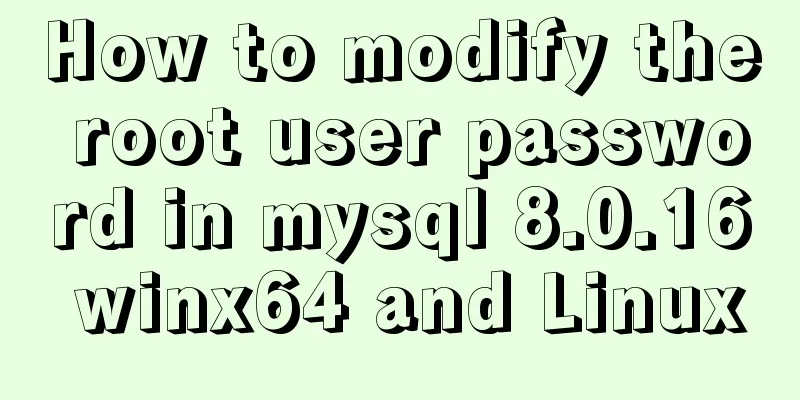How to modify the root user password in mysql 8.0.16 winx64 and Linux

|
Please handle basic operations such as connecting to the database by yourself. This article focuses on recording how to change the password. 1. Query user password: Query user password command: select host, user, authentication_string from mysql.user; host: The IP address 'location' that allows users to log in % indicates that it can be remote; user: the user name of the current database; authentication_string: user password (this field is mentioned later); 2. Set (or modify) user password: If the default root password is empty, you will not be able to connect using navicat (it seemed to be OK when I installed 5.7 before), so you need to change the root password here. This is a crucial step. I was fooled for a long time because of this. Later, I found out after a lot of research that the password field and password() function were deprecated after MySQL 5.7.9. authentication_string: field indicates the user password. 3. Steps to modify the root password: 1. If there is content under the authentication_string field of the current root user, you can set it to empty first, otherwise proceed directly to step 2. update user set authentication_string='' where user='root';#The password is set to empty 2. Use ALTER to modify the root user password. The method is ALTER user 'root'@'localhost' IDENTIFIED BY 'new password'. as follows: alter user 'root'@'%' identified with mysql_native_password by 'xxxx'; ALTER USER 'root'@'%' IDENTIFIED WITH mysql_native_password BY 'mypwd#2019'; or alter user 'root'@'localhost' identified with mysql_native_password by 'xxxx'; ALTER USER 'root'@'localhost' IDENTIFIED WITH mysql_native_password BY 'mypwd#2019' hint: The content following root@ is the Host field of the user table. The default for a new installation is localhost. Because remote access is added here, localhost is manually changed to %. After the change, you can execute: Note: The following method is no longer applicable for versions after MySQL 8.0. Remember! ! !
UPDATE user SET password=PASSWORD("new password") WHERE user='user name';If there is anything wrong with the above text, please correct it in detail and leave a message to facilitate our common growth in the future; I hope this blog can be helpful to you! You may also be interested in:
|
<<: How to monitor array changes in JavaScript
>>: Solution to the problem that docker logs cannot be retrieved
Recommend
JavaScript to implement drop-down list selection box
This article example shares the specific code of ...
Detailed tutorial on building an ETCD cluster for Docker microservices
Table of contents Features of etcd There are thre...
web.config (IIS) and .htaccess (Apache) configuration
xml <?xml version="1.0" encoding=&qu...
MySQL Community Server compressed package installation and configuration method
Today, because I wanted to install MySQL, I went ...
Problems encountered by MySQL nested transactions
MySQL supports nested transactions, but not many ...
Use of Linux watch command
1. Command Introduction The watch command execute...
The past two years with user experience
<br />It has been no more than two years sin...
Tomcat uses thread pool to handle remote concurrent requests
By understanding how tomcat handles concurrent re...
A comprehensive summary of frequently used statements in MySQL (must read)
The knowledge points summarized below are all fre...
Antdesign-vue combined with sortablejs to achieve the function of dragging and sorting two tables
Table of contents Achieve results Introduction to...
vue2.x configuration from vue.config.js to project optimization
Table of contents Preface vue.config.js configura...
Writing High-Quality Code Web Front-End Development Practice Book Excerpts
(P4) Web standards are composed of a series of sta...
MySQL login and exit command format
The command format for mysql login is: mysql -h [...
Introduction to CSS style classification (basic knowledge)
Classification of CSS styles 1. Internal style --...









